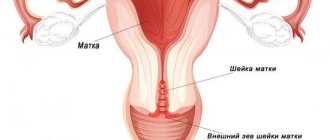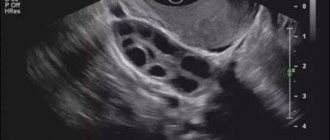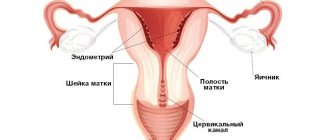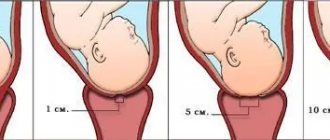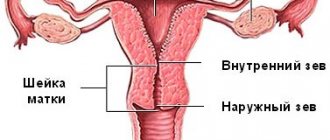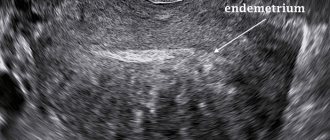The cervix (cervix) is the lower part of the organ that separates it from the vagina. It contains the cervical canal, which has mucous glands. During the menstrual cycle, it constantly changes its shape, consistency and other characteristics, and the nature of the discharge also changes. For example, during ovulation it rises to prepare for conception, and during the first days of menstruation it lowers and relaxes to ensure a good flow of menstrual blood.
Another important characteristic is the condition of the cervical canal. Normally, it is closed; in women who have given birth, the tip of the finger may be missing. The cervical canal expands in two cases - ovulation and the first days of menstruation.
Changes in the cervix by day of the cycle are associated with regular hormonal changes in a woman’s body, which are ensured by the activity of the hypothalamus, pituitary gland and ovaries. Therefore, after menopause, such cyclic changes stop. There are features in the location of the cervix during pregnancy.
Self-monitoring of the position, consistency of the cervix and discharge from the cervical canal is one of the ways to determine the phase of the menstrual cycle. This can be especially useful for pinpointing your ovulation day when trying to get pregnant.
Structural features
The cervix is the lower segment of the organ that connects to the vagina. It contains glands that produce mucus throughout the menstrual cycle. When pregnancy occurs, the cervix ensures that the fetus is held in its proper place, preventing the development of spontaneous miscarriage.
Normally, the cervix is a small, rounded formation. Its size does not exceed 4 cm in length and 2.5 cm in circumference. As part of a medical examination, a gynecologist can evaluate only the vaginal segment of the organ. The cervix has a hard consistency, a closed pharynx, which opens slightly during menstrual bleeding to allow discharge. However, the development of pregnancy leads to changes in some characteristics of the organ.
Possible pathologies
Processes occurring in the organs of the reproductive system during the gestational period may be accompanied by various pathologies. In isolated cases, conception can trigger the development of cancer, including cervical cancer.
According to statistics, 66% of expectant mothers are diagnosed with various pathologies of the lower segment of the uterus. Very often they are accompanied by infections and inflammation of the female genital organs. The most common pathologies of the cervix are:
- Deciduosis is characterized by the proliferation of tissue lining the internal cavity of the uterus. The factor that provokes the development of the disease is a significant increase in the production of progesterone. Excess tissue in the cervix area has a smooth surface and a white tint. The affected area may increase significantly during the gestational period. In most cases, after the baby is born, the endometrium is completely restored.
- The human papillomavirus affects the reproductive organs, and during pregnancy the risk of infection doubles (we recommend reading: papillomas during pregnancy: causes of appearance and treatment features). The disease is transmitted both sexually and domestically. Infected women develop warty tumors in the cervix and vagina. Increased growth of condylomas is observed in the second trimester. Progressive pathology can lead to the development of cervical cancer.
- Cervical dysplasia is a precancerous condition accompanied by the formation of atypical cells. Depending on the severity of the symptoms, three stages of the disease are distinguished: severe, moderate and mild. The prognosis for recovery depends on what stage of the disease is diagnosed in the woman. Low immunity, birth trauma, and unprotected sexual intercourse can contribute to the development of dysplasia.
The cervix changes greatly in early pregnancy. The vaginal part of the lower segment of the organ is very informative. It retains traces of previous pregnancies, childbirths and abortions. By its appearance, you can determine the period of the menstrual cycle, the fact of successful conception, and the duration of pregnancy.
Change in consistency
After conception, the cervix becomes soft to the touch. This is due to an increase in the production of progesterone, a hormone that is a companion to pregnancy. It leads to vasodilation, which causes swelling of the endometrium of the uterus. However, the cervix does not lose its firmness and elasticity, which allows the fertilized egg to be preserved. At the beginning of pregnancy, she gains mobility. This is due to the softening of the tissue of the isthmus, which is the part of the uterus that connects the body and the cervix.
The appearance of an embryo in the uterus leads to the activation of glands, which actively produce a thicker and more viscous secretion. A large clot of mucus appears in the cervical canal, which is called a “plug”. It performs the following functions:
- Protection of the uterine cavity from the penetration of infectious agents;
- Maintaining the balance of vaginal microflora;
- Creating optimal conditions for the functioning of the woman’s genital organs.
If after conception the consistency of the cervix remains hard, this indicates the development of hypertonicity of the organ. This pathological condition is characterized by increased tension in the uterus and can lead to rejection of the fertilized egg.
It is impossible to assess changes in the cervix yourself unless you are a specialist. Self-examinations can provoke the development of a vaginal infection and cervical injury. Therefore, only regular examinations by a gynecologist will allow pathology to be detected in time and corrected.
We determine ovulation by the position of the cervix
Another way to track your ovulation period is to determine the position of the cervix.
This method can be used by women trying to get pregnant, or women who are protecting themselves from unwanted pregnancy using natural methods. The method is especially effective if used in parallel with other methods of natural contraception, which include: Compared to the listed methods of tracking the stage of the menstrual cycle, determining the position of the cervix is not as common.
But if you observe all the manifestations of ovulation (basal temperature, cervical discharge, tests, well-being and position of the cervix), the likelihood that a woman will be able to correctly determine the fertile period of the menstrual cycle and use this knowledge to her advantage increases significantly.
Cervix at different periods of the menstrual cycle
- Days 5-8 of the menstrual cycle.
These days, the cervix is low, it is hard and elastic (like the tip of the nose), filled with a thick mucus plug. It remains closed for several days after menstruation to prevent infections from entering the woman's genital tract. It also prevents sperm from entering the uterus and therefore preventing pregnancy. Cervical mucus is either not secreted at all or is present in extremely scanty quantities. Therefore, these days are considered unfavorable for conception. - Days 9-12 of the menstrual cycle. This period is considered transitional.
The woman’s reproductive system is preparing for the upcoming ovulation: the cervix begins to gradually rise and open slightly. It becomes softer and begins to secrete its secretion, which helps moisturize the woman’s genital tract. The period is characterized by the release of sticky and sticky mucus.The probability of pregnancy these days increases slightly, but is still quite small.
- Days 13-15 of the menstrual cycle. By this time, the cervix is in its highest position. To the touch it becomes soft (like lips), loose, moist and slippery.
The cervical canal opens and the mucous plug gradually begins to emerge from it, which liquefies and at the exit is a liquid, in appearance and consistency, reminiscent of egg white.This time is considered the most favorable for pregnancy, since cervical mucus acquires qualities that facilitate the movement of sperm through the cervical canal into the woman’s uterus and further through the fallopian tubes to the egg.
- Day 16 of the menstrual cycle and beyond.
After ovulation has occurred, that is, the egg has left the ovary and reached the uterus, the cervix descends again, closes and becomes firm and elastic. Cervical discharge becomes scanty and viscous. This is necessary in order to protect the uterus with a possible embryo from infections and irritants that can penetrate the vagina.This period of the menstrual cycle is considered unfavorable for conception.
- Days before the start of the next menstrual cycle. If a woman keeps a menstrual calendar and her menstrual cycle is regular, she can guess when her next period will start. The position of the cervix in front of them can indicate whether pregnancy has occurred in the current cycle. The study can also be carried out on the days when the next menstruation is missed. So the cervix of a non-pregnant woman before menstruation is low, slightly open and softened. When pregnancy occurs, the cervix rises, closes and becomes hard.
The procedure for conducting a study of the qualities of the cervix
To learn how to correctly conduct a study and interpret its results, a woman will need 2-3 menstrual cycles. The research is specific, and you can only rely on your tactile sensations, based on which it is not so easy to draw conclusions. So follow these simple tips:
- conduct a study of the position of the cervix only if you do not have inflammatory or infectious diseases of the genital organs;
- start research when menstrual flow has ended;
- determine the position of the cervix once a day at approximately the same time;
- Before carrying out manipulations, wash your hands thoroughly;
- the finger you choose to determine the qualities of the cervix should not have a long, sharp nail, since the delicate epithelium of this organ can be damaged;
- It is convenient to conduct the examination while squatting, sitting on the toilet, or raising one leg (it can be placed on the edge of the bathtub or toilet). Having chosen the most comfortable position, do not change it until the end of the study;
- Do not rely on memory; write down all observations daily in a specially designated notebook.
After practicing for some time, you will learn to accurately determine the position, degree of hardness and opening of the cervix. Having remembered these sensations, a woman can conduct research only on the days when ovulation is expected to occur in order to determine her fertility.
Source: https://www.wait-kids.ru/encyclopedia/articles/planirovanie-beremennosti/opredelyaem-ovulyatsiyu-po-polozheniyu-sheyki-matki/
Changing Hue
Immediately after conception, processes begin to occur in a woman’s body that are aimed at maintaining the pregnancy. Usually the cervix is light pink, but during pregnancy it turns bluish-purple.
This is due to the rapid growth of the network of blood vessels in the organs of the reproductive system. The vessels fill with blood, which leads to their expansion and increases blood flow in the uterus. Increased blood supply to the genital organs also provokes swelling of the labia and vaginal walls.
How does the condition of the uterus change?
Constant monitoring of the condition of the reproductive organ is necessary to control the functioning of the reproductive system. Changes occur in the uterus during pregnancy, before menstrual bleeding, and also at the time of ovulation.
Before menstruation, fluid is retained in the cavity of the main reproductive organ and the main amount of nutrients enters it, due to this the size of the woman’s uterus increases significantly before menstruation. The endometrium acquires a loose structure; if conception does not occur during the cycle, the lining is torn off, and menstruation begins. After this, the stomach decreases.
Attention! Doctors report that the uterus enlarges before menstruation, which corresponds to 2-3 obstetric weeks of pregnancy, therefore a bimanual examination with a delay of 1-2 weeks is not effective.
After the onset of menstruation, the uterus enlarges and drops significantly, its pharynx opens slightly. The creation of such conditions is necessary to ensure the unimpeded exit of blood from the organ cavity. During bleeding, a layer of endometrium is removed from the cavity, which is rejected if there is no pregnancy. Its elimination is ensured by the tone of the reproductive organ and its contractions.
The particular danger of this period is the high risk of bacterial flora joining. It must be borne in mind that the pharynx opens slightly, and the amount of bactericidal secretion is significantly reduced; accordingly, pathogenic microorganisms can easily penetrate inside. Due to wounds resulting from endometrial rejection, microflora disturbances appear. The risk of infection can be reduced by following these rules:
- refusal to visit the pool and open water bodies;
- using pads instead of tampons;
- bathing in the shower rather than in the bath;
- refusal of intimacy or use of a condom.
The condition of the organ changes after the end of menstrual bleeding. After the end of menstruation, the pharynx closes and the uterus rises. Dry mucus forms in the cervix, preventing pathogenic contents from entering the cavity. Its color is transparent or white. The tissues of the cervical canal are loose and moist.
Change of location
After fertilization, a gradual descent of the cervix occurs, its deviation towards the posterior wall. This arrangement reduces the likelihood of spontaneous miscarriage. The placement height is a diagnostic sign that helps the doctor determine how the pregnancy is developing.
A high position is an alarming signal that may indicate the development of hypertonicity. In such situations, doctors hospitalize the patient. After all, only a relaxed state of the uterus allows you to bear a child normally. Constant tension of muscle fibers in most cases provokes embryo rejection.
Sometimes the high location of the lower segment of the uterus is an individual feature of the female body. In such cases, only an intravaginal ultrasound examination of the organ will help determine the presence of a threat of spontaneous abortion.
With a high position of the cervix, women note the development of the following symptoms:
- Watery discharge in large quantities;
- Frequent urge to urinate;
- The appearance of a nagging pain in the lower abdomen, in the lumbar region;
- The appearance of blood streaks in mucous secretions.
Such symptoms should alert a pregnant woman and become a reason for urgent consultation with a specialist.
What does the cervix look like before menstruation?
The premenstrual period is characterized by certain changes in the female body and reproductive system. Before menstruation, the cervix drops, its edges become loose, and it itself is soft and slightly open. All practicing gynecologists know exactly how the cervix should correspond to a certain period of the menstrual cycle.
Shortly before menstruation, a woman’s body prepares to reject the old uterine epithelium and blood fibers, which is why the cervix smoothes out a little and opens slightly, allowing all secretions to leave the uterus. Thus, a complete menstrual cycle passes, and after the completion of menstruation and the ovulation period, menstruation begins again.
How is the organ examined after fertilization?
If pregnancy occurs, the woman should consult a gynecologist. The doctor will perform a gynecological examination using speculum and two-handed examination. Additionally, a study of the vaginal microflora will be required to ensure the absence of sexually transmitted infections that could threaten the fetus.
It is necessary to conduct cytology - a histological examination of cervical cells. This is necessary to prevent the development of cancer. The fact is that during pregnancy, a woman’s immunity is suppressed in order to prevent fetal rejection. This process can trigger the rapid growth of cancer cells that are in the body.
When pregnancy occurs, the development of the following diseases should be additionally excluded:
- Endocervicitis. This is an infectious lesion of the cervix, which can provoke the penetration of bacteria into the uterine cavity, infection of the fetus, decreased tone of the organ and spontaneous abortion. Therefore, it is necessary to promptly determine the presence of infection and begin therapy;
- Erosion (small ulcer on the uterine mucosa). The cause of the pathological formation may be pregnancy or infection. The disease requires constant monitoring by a specialist, but treatment is carried out only after delivery.
The listed changes in the cervix allow the gynecologist to draw a conclusion about the occurrence of pregnancy, its duration, and the development of threatening factors. You should not engage in self-diagnosis, because it can lead to the development of dangerous diseases and termination of pregnancy. Regular examinations with a doctor will allow you to monitor any changes in the process of bearing a child and stop pathologies in a timely manner.
(voted: 3, rating: 4.67 out of 5)
Share the news on social networks
Ask a Question! You have questions? Feel free to ask any questions! And our staff specialist will help you. Go>>
Tags: Cervix
- Recommended Articles
- Abstinence before conception
- Pregnancy test Evitest
- Boy conception calendar
« Previous entry
Reproductive cycle when planning pregnancy – Elevit
You are one step away from the innovative Qapsula tool! He will help you find a gynecologist in your city or region.
BOOK YOUR ONLINE APPOINTMENT RIGHT NOW!
I confirm
Dear visitor
You go to the website www.qapsula.com. By clicking the “I confirm” button, you agree that:
The website www.qapsula.com (hereinafter referred to as the “Site”) is a platform for posting information that is used by users of the Site and healthcare professionals solely at their own discretion.
BAYER JSC refrains from any influence on the decisions of users regarding the use or non-use of the Site, as well as from any guarantees and recommendations regarding healthcare professionals, medical institutions, medicines, information and other resources mentioned on the Site.
Bayer JSC is not responsible for the accuracy and relevance of the information obtained when using the Site and/or communication organized through the Site, for any actions taken by users based on the above information, as well as for damage or loss to users or third parties caused in as a result of communication with healthcare professionals organized through the Site.
Recommendations and opinions on health and medical issues published on the Site, or received by Site users when communicating with healthcare professionals, do not constitute the provision of medical services or consultations, do not replace qualified medical care, are for informational purposes only and do not replace the need to see a doctor in person. consultation.,
L.RU.MR.11.2017.0580
Calendar recording of the days of the menstrual cycle helps determine the period of greatest likelihood of fertilization and increase the chances of pregnancy.
The concept of the most favorable time for conception
The most favorable time for conception and the best time for sex are the few days leading up to ovulation and the day of ovulation.
If you delay contact with your partner until after ovulation, the sperm may not have time to reach the egg in time and fertilization will not occur. Sperm remains viable in the uterine cavity for several days, i.e. To increase the chances of conception, it is best to have sex 1-2 days before planned ovulation.
Having sex during your most fertile phase can improve your chances of conceiving.
Other signs that determine the most favorable time for conception include:
- Changes in the nature of cervical mucus. The cervix is the lower, narrow part of the uterus that opens into the vagina. The nature of the mucus produced by the cervix during the menstrual cycle changes under the influence of hormones and can promote conception.
Before ovulation (immediately after menstruation).Very little or no mucus is produced. The mucus will be thick, sticky, white or opaque, and the vagina will remain dry. Because
Sperm requires mucus to meet the egg; the likelihood of pregnancy at this stage is low.
On the eve of ovulation.
Mucus production increases, the mucus becomes creamy white or creamy in color, and the vagina feels moist. At this time, the likelihood of pregnancy is higher.
During the period of ovulation.
The mucus becomes less thick, transparent and very viscous (like the white of a raw egg), and moisture is felt in the vagina. During this period, the likelihood of pregnancy is greatest.
After ovulation.
The mucus will become thick and sticky again, and the vagina will remain dry. The likelihood of conception will begin to decrease.
- Increase in basal body temperature. Basal body temperature is the body temperature at rest.
Recording your basal temperature over several months can help you predict the timing of ovulation more accurately. Ovulation usually occurs at the beginning of a rise in temperature that lasts for at least 3 days. Factors such as temperature changes, travel, time of day, diet, working hours and sleep duration affect body temperature. To get accurate data, it is best to take your temperature every morning at the same time, before getting out of bed, using a fertility thermometer or digital thermometer. - Stomach ache. Try to pay attention to any abdominal pain, as a slight nagging pain may be a sign of ovulation.
- Premenstrual symptoms. During ovulation, you may also experience typical premenstrual symptoms, such as breast enlargement, breast pain, bloating, or mood swings.
General questions about conception
- Does age affect fertility? Yes, the quality of eggs and ovulation patterns depend on your age.
The greatest fertility is characteristic of women aged 20 to 30 years. Age also affects the quality and quantity of sperm. - How long will it take to get pregnant? In half of couples, pregnancy occurs within 2-3 months, in 85% - within 1 year.1,2 However, it is important to understand that all couples are different.
It is best to relax and take a calm approach to the issue of conceiving a child, since stress is not conducive to pregnancy. - What to do if pregnancy does not occur? If you are doing everything correctly, and pregnancy does not occur within 6 months, consult your doctor for advice.
The process of conception by day
Discussion: 7 comments
- Bela:
09.24.2018 at 20:05Hello, I want, my friend asks, can she get pregnant because she […]?
Answer
Yana (specialist):
09.24.2018 at 21:47
There is a possibility, but most likely very small.
Answer
04/28/2019 at 09:19
Hello, please tell me on March 14 it was PA, on April 2 they arrived M, on April 9 they ended, is there a possibility of pregnancy?
Answer
- Daria:
02.05.2019 at 19:22
Hello Maria! It is logical that you can no longer get pregnant from a PA that occurred on March 14. Try again, there is a possibility, if you find any abnormalities, consult a doctor!
Answer
04/29/2019 at 19:49
Good afternoon. I gave a smear to the lcd. Showed an elevated leukocyte level of 100. They said it was inflammation. Could this cause problems with conception?
Answer
- Daria:
02.05.2019 at 19:01
Hello, Ekaterina! Inflammation of the organs of the reproductive system and not only can affect your health, hence conception and further pregnancy. Therefore, first eliminate the inflammation, lower the level of leukocytes to normal, and then proceed to planning a pregnancy if no other problems are found.
Answer
04/07/2020 at 13:57
Hello, I have a b.t 36.5 for two days now, the O test showed two good lines on 04/02, PA was also on 04/02, after O there was a slightly whitish liquid discharge and now there is clear, thick mucus in small quantities, my breasts have become sensitive, is pregnancy or onovulatory possible? cycle maybe, before it was always b.t. 37 after supposedly Oh, I'm 42
Answer
Palpation of the uterus at home
Often girls, before going to the doctor, want to independently check their assumptions regarding the condition of the reproductive organ. With some basic knowledge and skills, you can identify its various conditions at home. Before menstruation, the cervix is slightly lower than during pregnancy. During pregnancy, the cervix is high, tightly closed, and the uterus itself has a loose structure.
It is impossible to judge the condition of an organ solely on the basis of palpation. For an accurate diagnosis, it is necessary to be examined by a doctor.
How to palpate
Self-palpation is carried out only for informational purposes or if it is not possible to visit a specialist.
If a woman decides to carry out such an event on her own, one should not forget about the possible disadvantages of this technique. To carry out palpation without any consequences, you must remember the following instructions from gynecologists:
nails must be short and clean before performing this technique; hands should be thoroughly washed and dried; Before palpation, you should put on sterile latex gloves; gently insert the index and middle fingers into the vagina; carefully feel the rounded tubercle in the vagina, draw a certain conclusion for yourself based on the data obtained and remove your fingers from the vagina; take hygiene measures. https://youtube.com/watch?v=Kp-5UNSvjtg
https://youtube.com/watch?v=Kp-5UNSvjtg
Disadvantages of palpation at home
Self-diagnosis of the cervix during menstruation is used only if necessary, as it has a number of disadvantages. These include the following:
if hygiene measures are not observed, there is a risk of infection and infectious diseases; if palpation is carried out without due care, there is a possibility of damaging the cervix, which will cause erosion; it is difficult to determine exactly what the condition of the organ indicates due to the lack of experience and knowledge in this area; The need to see a doctor still does not disappear, since the woman cannot make an accurate diagnosis on her own. Self-diagnosis of the cervix during menstruation or its absence is very dangerous
Even if a woman has experience and theoretical knowledge in this area, she should not draw hasty conclusions. You should consult a specialist for a reliable diagnosis of the reproductive organ
It is very dangerous to independently diagnose the cervix during menstruation or its absence. Even if a woman has experience and theoretical knowledge in this area, she should not draw hasty conclusions. You should consult a specialist for a reliable diagnosis of the reproductive organ.
Diagnostic technique
In order for you to be able to differentiate what an open or closed cervix is, soft, hard or loose, you will need experience that lasts for 3 to 4 cycles. The difference will be noticeable when the cervix is before and after menstruation. Only time and constant training will help you become an excellent diagnostician for your own body.
- Of course, only after menstruation!;
- Don't abuse it! Once a day is enough;
- Regularity. Always perform manipulations at the same time;
- If there are infections or inflammatory processes, self-diagnosis will have to be postponed indefinitely.
If you decide to check what the cervix is like before your period, we first advise you to repeat the anatomy of the female reproductive system again, study the structure of the uterus and its appendages from a photo. After active intellectual preparation, move on to practice.
For work, prepare your own hands - remove long nails, thoroughly disinfect your hands, put on disposable gloves. Choose a position that is comfortable for you - squatting, on the toilet, or raising one leg on the edge of the bathtub for support.
Insert two fingers slowly into the vagina, feeling the peculiar tubercle will tell you that you have reached the uterus. Determining the consistency and accessibility of the cervical canal is a matter of time, as mentioned above, and therefore a study should be carried out every day for comparison.
Before you begin a gynecological examination, you should carefully prepare:
- Trim your nails. Otherwise, there is a possibility of injury to the surface of the ball.
- Wash your hands thoroughly to avoid infection.
- Wear sterile medical gloves; they will protect the uterus from penetration of pathogenic microorganisms.
The best position for the examination is sitting. To make it more comfortable, you can sit on the toilet or bidet. But it’s better to squat down or simply raise your leg and fix it on a hill. If it is more convenient to feel the cervix while lying down, you can conduct a self-examination in this position. Two fingers (middle and index) are inserted into the vagina. Watch your movements; they should not be sudden, so as not to cause injury to the mucous membrane.
During the examination, you will find a dense tubercle under your fingers; this is the cervix. If you have the appropriate experience, you can easily determine whether it is hard or, conversely, soft. It is also easy to understand the state of the cervical canal - closed or open - this indicates ovulation or other conditions.
Reasons for inspection
Regular examination is primarily necessary for the timely detection of developing tumors, malignant or benign, since even at an early stage of the development of the disease there are certain signs, and it is at this time that treatment can be most effectively carried out.
Since modern technologies have not yet reached all corners of the Earth and in some villages there are no ultrasound machines familiar to us, gynecologists, through examination, determine the condition of a woman’s reproductive system by the shape of the pharynx. The cervix before menstruation has the shape of a pupil, but if the shape changes, then we can conclude that there is a lack of estrogen or a dysfunction of the corpus luteum.
Is self-diagnosis allowed?
Self-examinations can be carried out, especially if a woman feels unwell or is worried about something. Learning to accurately determine the condition and position of the uterus is not an easy task. But experience comes with time. If you conduct self-examination regularly, then after just a few cycles you will be able to accurately diagnose the condition of your body and reproductive system.
Diagnosis is carried out in compliance with certain simple but very important rules. These conditions must be strictly observed:
- no examinations during the menstrual cycle, this is fraught with infection;
- First of all, remember: you should not self-examine more than once a day, it is better to do it 3 times a week;
- It is advisable to carry out manipulations at the same time;
- if there is inflammation, diagnosis will have to be postponed.
Self-examination of the uterus does not give a complete picture of its condition, but will only help make some assumptions. Perhaps this is the only positive side of this procedure. But there are many more negative aspects. This is also the possibility of infection, trauma, which threatens inflammation, complications that lead to infertility.
A photo of what the cervix looks like before menstruation and during pregnancy cannot help analyze the condition of the organ. You should be guided only by tactile sensations.
If you have any questions, you can always ask your gynecologist. If necessary, a woman can conduct an independent examination of the cervix, but this should be done only in extreme situations and no more than three times a week.
To determine the condition of an organ, considerable experience is required, which means that in its absence, the examination will be uninformative and will not yield any results. Only an experienced doctor is able to recognize changes, evaluate them and prescribe additional examination methods, because the position of the cervix is constantly changing by day of the cycle, and these features must be taken into account.
